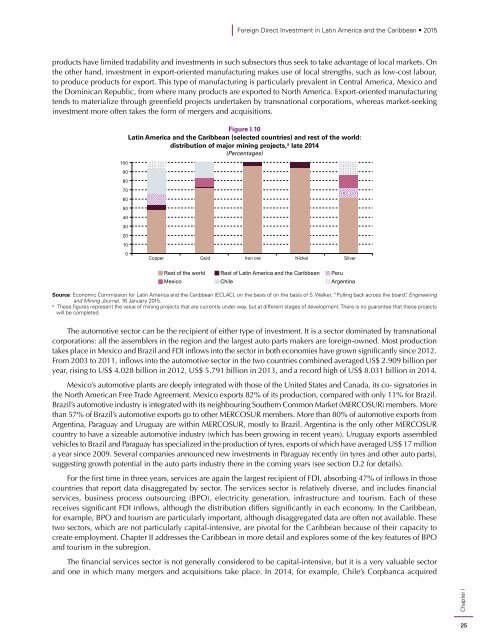Foreign Direct Investment in Latin America and the Caribbean 2015
In its latest edition, the Foreign Direct Investment in Latin America and the Caribbean report analyzes in-depth the FDI received by the Caribbean, where these flows are much more significant than in the rest of the region as a proportion of Gross Domestic Product (GDP). The study also examines the impact of FDI on the environment, which has not been measured or regulated sufficiently by countries in the region.
In its latest edition, the Foreign Direct Investment in Latin America and the Caribbean report analyzes in-depth the FDI received by the Caribbean, where these flows are much more significant than in the rest of the region as a proportion of Gross Domestic Product (GDP). The study also examines the impact of FDI on the environment, which has not been measured or regulated sufficiently by countries in the region.
Create successful ePaper yourself
Turn your PDF publications into a flip-book with our unique Google optimized e-Paper software.
<strong>Foreign</strong> <strong>Direct</strong> <strong>Investment</strong> <strong>in</strong> Lat<strong>in</strong> <strong>America</strong> <strong>and</strong> <strong>the</strong> <strong>Caribbean</strong> • <strong>2015</strong><br />
products have limited tradability <strong>and</strong> <strong>in</strong>vestments <strong>in</strong> such subsectors thus seek to take advantage of local markets. On<br />
<strong>the</strong> o<strong>the</strong>r h<strong>and</strong>, <strong>in</strong>vestment <strong>in</strong> export-oriented manufactur<strong>in</strong>g makes use of local strengths, such as low-cost labour,<br />
to produce products for export. This type of manufactur<strong>in</strong>g is particularly prevalent <strong>in</strong> Central <strong>America</strong>, Mexico <strong>and</strong><br />
<strong>the</strong> Dom<strong>in</strong>ican Republic, from where many products are exported to North <strong>America</strong>. Export-oriented manufactur<strong>in</strong>g<br />
tends to materialize through greenfield projects undertaken by transnational corporations, whereas market-seek<strong>in</strong>g<br />
<strong>in</strong>vestment more often takes <strong>the</strong> form of mergers <strong>and</strong> acquisitions.<br />
100<br />
90<br />
80<br />
70<br />
60<br />
50<br />
40<br />
30<br />
20<br />
10<br />
Figure I.10<br />
Lat<strong>in</strong> <strong>America</strong> <strong>and</strong> <strong>the</strong> <strong>Caribbean</strong> (selected countries) <strong>and</strong> rest of <strong>the</strong> world:<br />
distribution of major m<strong>in</strong><strong>in</strong>g projects, a late 2014<br />
(Percentages)<br />
0<br />
Copper Gold Iron ore Nickel Silver<br />
Rest of <strong>the</strong> world Rest of Lat<strong>in</strong> <strong>America</strong> <strong>and</strong> <strong>the</strong> <strong>Caribbean</strong> Peru<br />
Mexico Chile Argent<strong>in</strong>a<br />
Source: Economic Commission for Lat<strong>in</strong> <strong>America</strong> <strong>and</strong> <strong>the</strong> <strong>Caribbean</strong> (ECLAC), on <strong>the</strong> basis of on <strong>the</strong> basis of S. Walker, “Pull<strong>in</strong>g back across <strong>the</strong> board”, Eng<strong>in</strong>eer<strong>in</strong>g<br />
<strong>and</strong> M<strong>in</strong><strong>in</strong>g Journal, 16 January <strong>2015</strong>.<br />
a<br />
These figures represent <strong>the</strong> value of m<strong>in</strong><strong>in</strong>g projects that are currently under way, but at different stages of development. There is no guarantee that <strong>the</strong>se projects<br />
will be completed.<br />
The automotive sector can be <strong>the</strong> recipient of ei<strong>the</strong>r type of <strong>in</strong>vestment. It is a sector dom<strong>in</strong>ated by transnational<br />
corporations: all <strong>the</strong> assemblers <strong>in</strong> <strong>the</strong> region <strong>and</strong> <strong>the</strong> largest auto parts makers are foreign-owned. Most production<br />
takes place <strong>in</strong> Mexico <strong>and</strong> Brazil <strong>and</strong> FDI <strong>in</strong>flows <strong>in</strong>to <strong>the</strong> sector <strong>in</strong> both economies have grown significantly s<strong>in</strong>ce 2012.<br />
From 2003 to 2011, <strong>in</strong>flows <strong>in</strong>to <strong>the</strong> automotive sector <strong>in</strong> <strong>the</strong> two countries comb<strong>in</strong>ed averaged US$ 2.909 billion per<br />
year, ris<strong>in</strong>g to US$ 4.028 billion <strong>in</strong> 2012, US$ 5.791 billion <strong>in</strong> 2013, <strong>and</strong> a record high of US$ 8.031 billion <strong>in</strong> 2014.<br />
Mexico’s automotive plants are deeply <strong>in</strong>tegrated with those of <strong>the</strong> United States <strong>and</strong> Canada, its co- signatories <strong>in</strong><br />
<strong>the</strong> North <strong>America</strong>n Free Trade Agreement. Mexico exports 82% of its production, compared with only 11% for Brazil.<br />
Brazil’s automotive <strong>in</strong>dustry is <strong>in</strong>tegrated with its neighbour<strong>in</strong>g Sou<strong>the</strong>rn Common Market (MERCOSUR) members. More<br />
than 57% of Brazil’s automotive exports go to o<strong>the</strong>r MERCOSUR members. More than 80% of automotive exports from<br />
Argent<strong>in</strong>a, Paraguay <strong>and</strong> Uruguay are with<strong>in</strong> MERCOSUR, mostly to Brazil. Argent<strong>in</strong>a is <strong>the</strong> only o<strong>the</strong>r MERCOSUR<br />
country to have a sizeable automotive <strong>in</strong>dustry (which has been grow<strong>in</strong>g <strong>in</strong> recent years). Uruguay exports assembled<br />
vehicles to Brazil <strong>and</strong> Paraguay has specialized <strong>in</strong> <strong>the</strong> production of tyres, exports of which have averaged US$ 17 million<br />
a year s<strong>in</strong>ce 2009. Several companies announced new <strong>in</strong>vestments <strong>in</strong> Paraguay recently (<strong>in</strong> tyres <strong>and</strong> o<strong>the</strong>r auto parts),<br />
suggest<strong>in</strong>g growth potential <strong>in</strong> <strong>the</strong> auto parts <strong>in</strong>dustry <strong>the</strong>re <strong>in</strong> <strong>the</strong> com<strong>in</strong>g years (see section D.2 for details).<br />
For <strong>the</strong> first time <strong>in</strong> three years, services are aga<strong>in</strong> <strong>the</strong> largest recipient of FDI, absorb<strong>in</strong>g 47% of <strong>in</strong>flows <strong>in</strong> those<br />
countries that report data disaggregated by sector. The services sector is relatively diverse, <strong>and</strong> <strong>in</strong>cludes f<strong>in</strong>ancial<br />
services, bus<strong>in</strong>ess process outsourc<strong>in</strong>g (BPO), electricity generation, <strong>in</strong>frastructure <strong>and</strong> tourism. Each of <strong>the</strong>se<br />
receives significant FDI <strong>in</strong>flows, although <strong>the</strong> distribution differs significantly <strong>in</strong> each economy. In <strong>the</strong> <strong>Caribbean</strong>,<br />
for example, BPO <strong>and</strong> tourism are particularly important, although disaggregated data are often not available. These<br />
two sectors, which are not particularly capital-<strong>in</strong>tensive, are pivotal for <strong>the</strong> <strong>Caribbean</strong> because of <strong>the</strong>ir capacity to<br />
create employment. Chapter II addresses <strong>the</strong> <strong>Caribbean</strong> <strong>in</strong> more detail <strong>and</strong> explores some of <strong>the</strong> key features of BPO<br />
<strong>and</strong> tourism <strong>in</strong> <strong>the</strong> subregion.<br />
The f<strong>in</strong>ancial services sector is not generally considered to be capital-<strong>in</strong>tensive, but it is a very valuable sector<br />
<strong>and</strong> one <strong>in</strong> which many mergers <strong>and</strong> acquisitions take place. In 2014, for example, Chile’s Corpbanca acquired<br />
Chapter I<br />
25


















